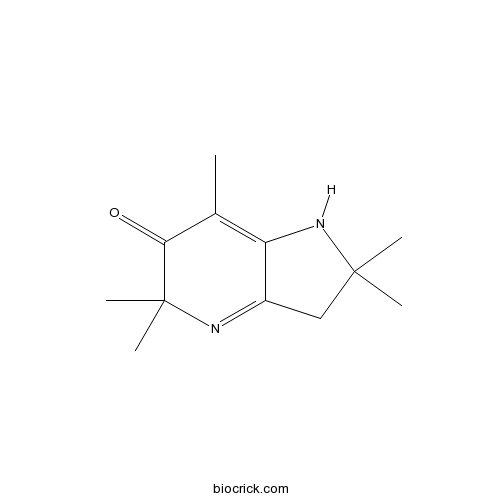AgrocybenineCAS# 178764-92-6 |

Quality Control & MSDS
3D structure
Package In Stock
Number of papers citing our products

| Cas No. | 178764-92-6 | SDF | Download SDF |
| PubChem ID | 23278458 | Appearance | Yellow Powder |
| Formula | C12H18N2O | M.Wt | 206.3 |
| Type of Compound | Alkaloids | Storage | Desiccate at -20°C |
| Solubility | Soluble in Chloroform,Dichloromethane,Ethyl Acetate,DMSO,Acetone,etc. | ||
| Chemical Name | 2,2,5,5,7-pentamethyl-1,3-dihydropyrrolo[3,2-b]pyridin-6-one | ||
| SMILES | CC1=C2C(=NC(C1=O)(C)C)CC(N2)(C)C | ||
| Standard InChIKey | OTBGQBSPIWKINO-UHFFFAOYSA-N | ||
| Standard InChI | InChI=1S/C12H18N2O/c1-7-9-8(6-11(2,3)14-9)13-12(4,5)10(7)15/h14H,6H2,1-5H3 | ||
| General tips | For obtaining a higher solubility , please warm the tube at 37 ℃ and shake it in the ultrasonic bath for a while.Stock solution can be stored below -20℃ for several months. We recommend that you prepare and use the solution on the same day. However, if the test schedule requires, the stock solutions can be prepared in advance, and the stock solution must be sealed and stored below -20℃. In general, the stock solution can be kept for several months. Before use, we recommend that you leave the vial at room temperature for at least an hour before opening it. |
||
| About Packaging | 1. The packaging of the product may be reversed during transportation, cause the high purity compounds to adhere to the neck or cap of the vial.Take the vail out of its packaging and shake gently until the compounds fall to the bottom of the vial. 2. For liquid products, please centrifuge at 500xg to gather the liquid to the bottom of the vial. 3. Try to avoid loss or contamination during the experiment. |
||
| Shipping Condition | Packaging according to customer requirements(5mg, 10mg, 20mg and more). Ship via FedEx, DHL, UPS, EMS or other couriers with RT, or blue ice upon request. | ||
| Description | Standard reference |
| In vitro | Pyrrolo-isoquinoline and glycosylated pyrrolidine alkaloids from Nigella glandulifera and their anti-PTP1B activity[Reference: WebLink]Phytochemistry Letters, 2017 , 19 :168-171.
|
| Structure Identification | Tetrahedron Letters.1996 June 24;37(36):4549–4550.Agrocybenine, novel class alkaloid from the Korean mushroom Agrocybe cylindracea.[Reference: WebLink]
|

Agrocybenine Dilution Calculator

Agrocybenine Molarity Calculator
| 1 mg | 5 mg | 10 mg | 20 mg | 25 mg | |
| 1 mM | 4.8473 mL | 24.2365 mL | 48.4731 mL | 96.9462 mL | 121.1827 mL |
| 5 mM | 0.9695 mL | 4.8473 mL | 9.6946 mL | 19.3892 mL | 24.2365 mL |
| 10 mM | 0.4847 mL | 2.4237 mL | 4.8473 mL | 9.6946 mL | 12.1183 mL |
| 50 mM | 0.0969 mL | 0.4847 mL | 0.9695 mL | 1.9389 mL | 2.4237 mL |
| 100 mM | 0.0485 mL | 0.2424 mL | 0.4847 mL | 0.9695 mL | 1.2118 mL |
| * Note: If you are in the process of experiment, it's necessary to make the dilution ratios of the samples. The dilution data above is only for reference. Normally, it's can get a better solubility within lower of Concentrations. | |||||

Calcutta University

University of Minnesota

University of Maryland School of Medicine

University of Illinois at Chicago

The Ohio State University

University of Zurich

Harvard University

Colorado State University

Auburn University

Yale University

Worcester Polytechnic Institute

Washington State University

Stanford University

University of Leipzig

Universidade da Beira Interior

The Institute of Cancer Research

Heidelberg University

University of Amsterdam

University of Auckland

TsingHua University

The University of Michigan

Miami University

DRURY University

Jilin University

Fudan University

Wuhan University

Sun Yat-sen University

Universite de Paris

Deemed University

Auckland University

The University of Tokyo

Korea University
- rel-(8R,8'R)-dimethyl-(7S,7'R)-bis(3,4-methylenedioxyphenyl)tetrahydro-furan
Catalog No.:BCN1521
CAS No.:178740-32-4
- CFM-2
Catalog No.:BCC6931
CAS No.:178616-26-7
- U-104
Catalog No.:BCC2312
CAS No.:178606-66-1
- Oleoside
Catalog No.:BCN1134
CAS No.:178600-68-5
- ZD 2079
Catalog No.:BCC5878
CAS No.:178600-17-4
- Prilocaine hydrochloride
Catalog No.:BCC4288
CAS No.:1786-81-8
- Hoechst 33342 analog
Catalog No.:BCC1630
CAS No.:178481-68-0
- Vitexin -4''-O-glucoside
Catalog No.:BCN3054
CAS No.:178468-00-3
- 6-epi-Albrassitriol
Catalog No.:BCN7342
CAS No.:178456-58-1
- Agrostophyllidin
Catalog No.:BCN3598
CAS No.:178439-50-4
- AR-R 17779 hydrochloride
Catalog No.:BCC7827
CAS No.:178419-42-6
- Tos-Arg-OMe.HCl
Catalog No.:BCC2874
CAS No.:1784-03-8
- Delta3,2-Hydroxylbakuchiol
Catalog No.:BCN3707
CAS No.:178765-49-6
- 3-Hydroxybakuchiol
Catalog No.:BCN3610
CAS No.:178765-54-3
- 12-Hydroxyisobakuchiol
Catalog No.:BCN3609
CAS No.:178765-55-4
- SNC 162
Catalog No.:BCC7103
CAS No.:178803-51-5
- Vitexolide D
Catalog No.:BCN6739
CAS No.:1788090-69-6
- Myricadiol
Catalog No.:BCN1135
CAS No.:17884-88-7
- Salviaflaside
Catalog No.:BCN8330
CAS No.:178895-25-5
- NGD 94-1
Catalog No.:BCC7636
CAS No.:178928-68-2
- 3-(4-Pyridyl)-Alanine
Catalog No.:BCC2651
CAS No.:178933-04-5
- FT-207 (NSC 148958)
Catalog No.:BCC4455
CAS No.:17902-23-7
- CPCCOEt
Catalog No.:BCC6896
CAS No.:179067-99-3
- PHCCC
Catalog No.:BCC6895
CAS No.:179068-02-1
Piperidine Alkaloids with Diverse Skeletons from Anacyclus pyrethrum.[Pubmed:29775308]
J Nat Prod. 2018 Jun 22;81(6):1474-1482.
Fifteen new piperidine derivatives, pyracyclumines A-J (1-10), including five pairs of enantiomers, (+)-1/(-)-1 to (+)-5/(-)-5, together with three known compounds, Agrocybenine (11), 4,6,6-trimethyl-5,6-dihydro-2(1 H)-pyridone (12), and 3,5,5-trimethyl-1,5-dihydro-2 H-pyrrol-2-one (13), were isolated from the roots of Anacyclus pyrethrum. Pyracyclumines A, B, and H (1, 2, and 8) possess a novel 6/5/6/6 dimeric piperidine skeleton, a unique 6/5/6 dimeric piperidine skeleton, and a 1,4,6-triazaindan skeleton, respectively. Pyracyclumine C (3) is based on a rare cyclopentane-piperidine framework. The structures of the isolated compounds were established by analysis of their NMR and HRESIMS data. The racemic pyracyclumines A-E (1-5) were further separated by chiral HPLC to give the enantiomers (+)-1/(-)-1 to (+)-5/(-)-5, for which the absolute configurations were determined by comparison of their experimental and calculated ECD spectra. The plausible biogenetic pathways of these piperidine alkaloids were proposed starting from the basic units of compounds 12 and 13. All of the isolated compounds were tested for their inhibitory effects on menin-mixed lineage leukemia 1 protein-protein interaction.


